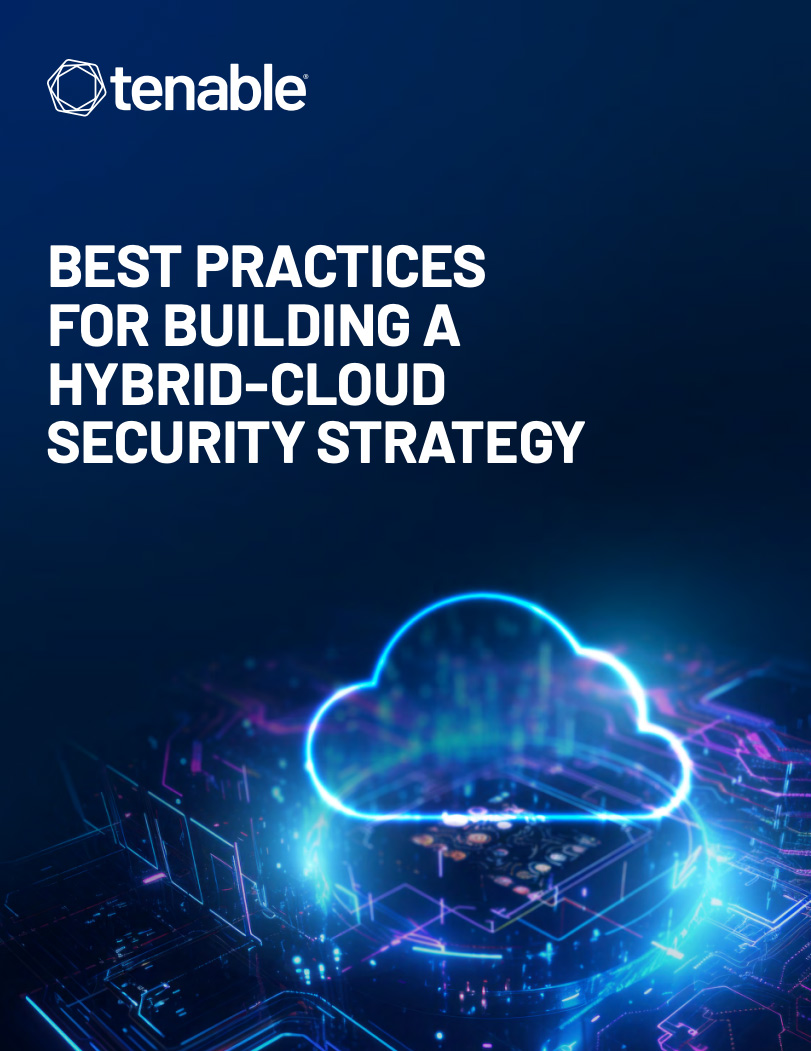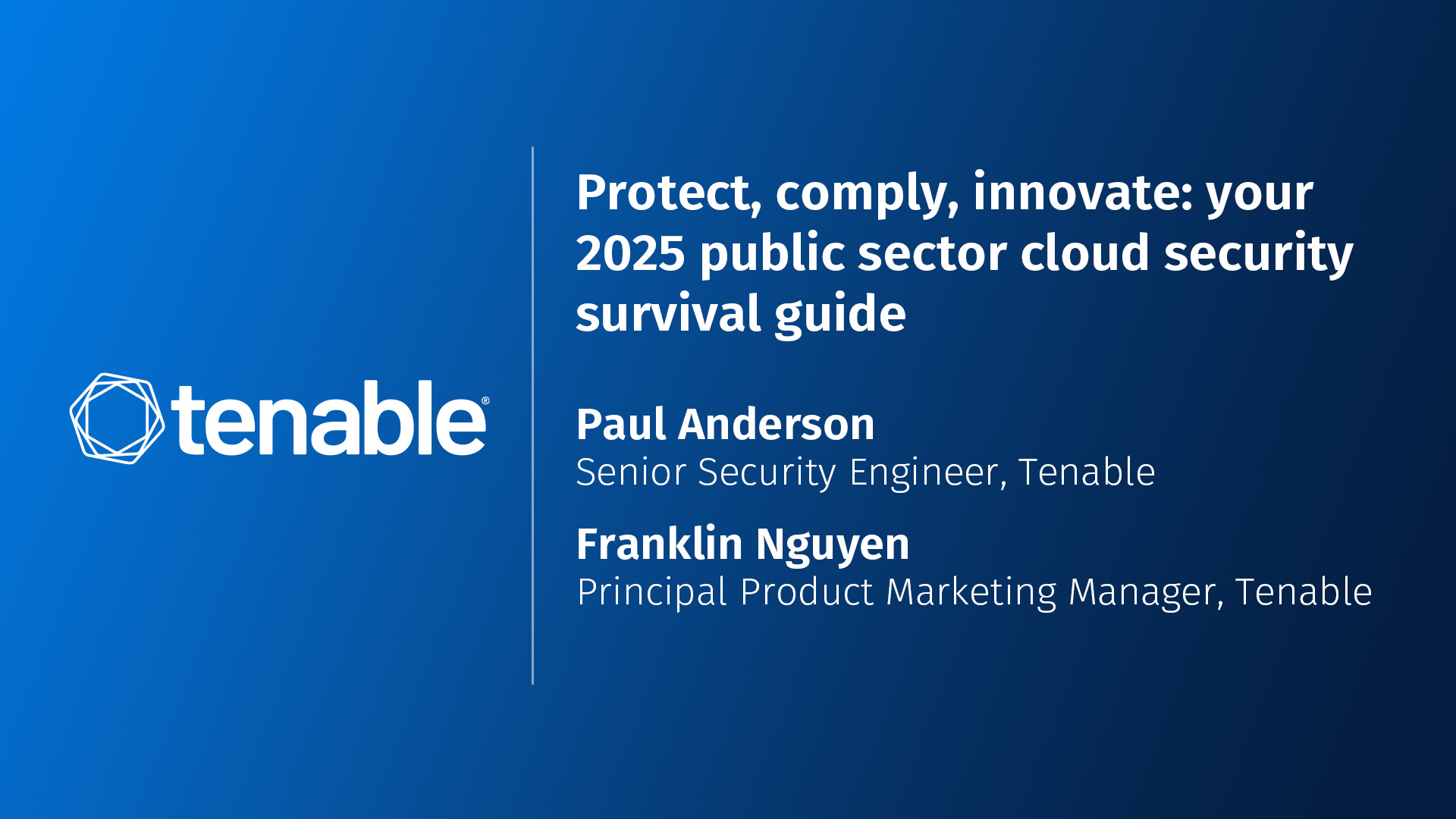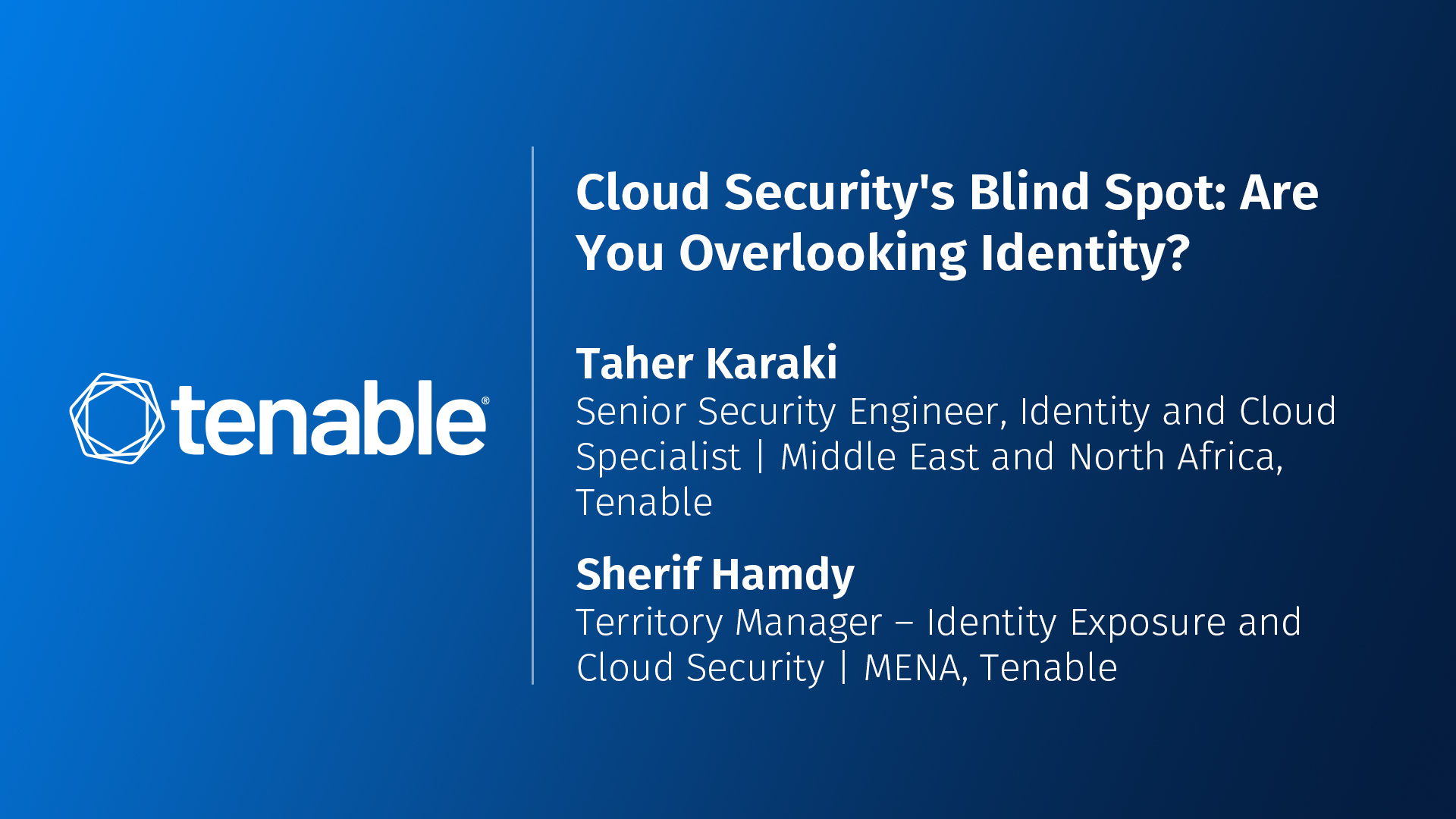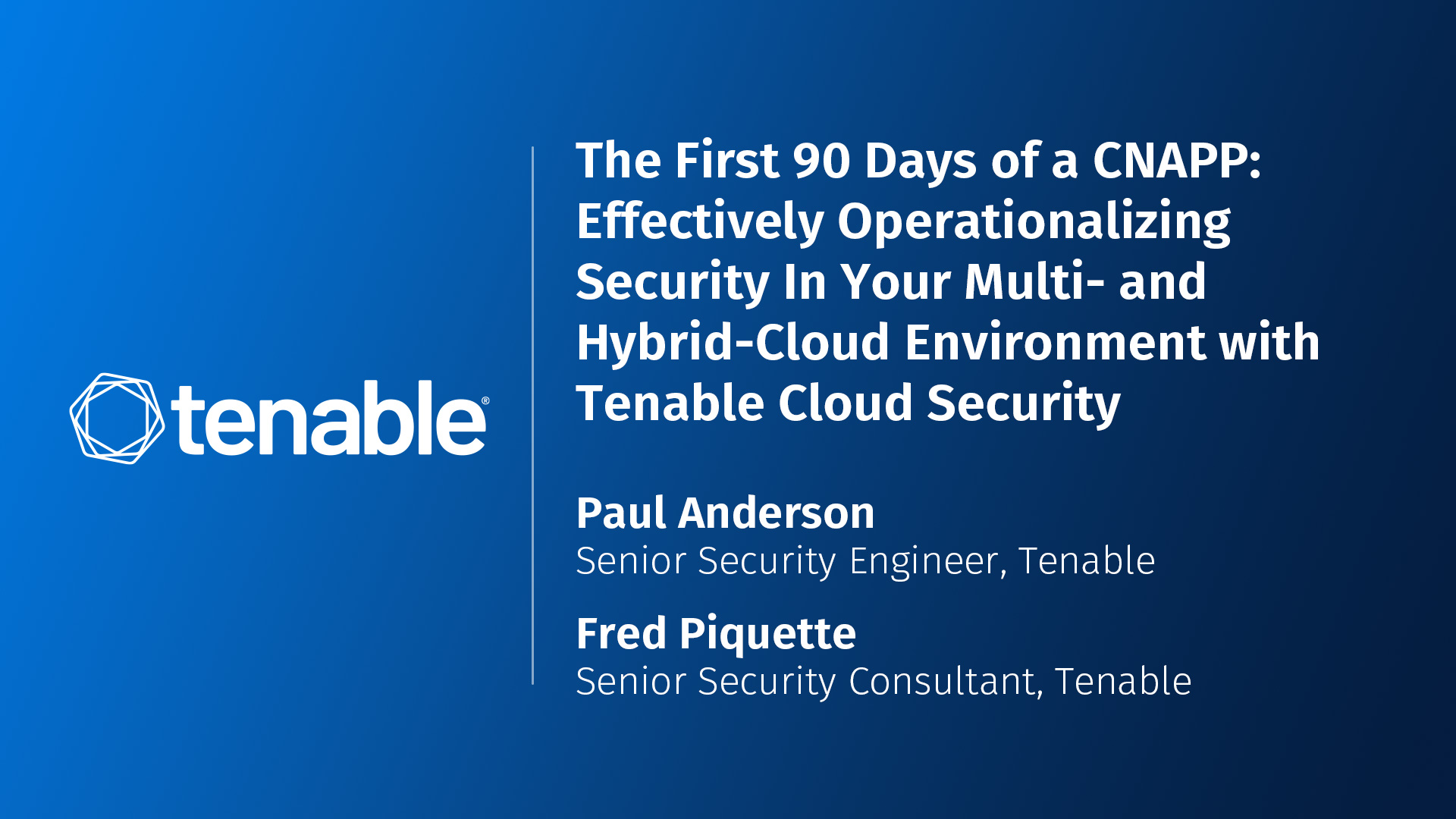Seguridad en la nube: Visibility and insight into all of your cloud infrastructure
Cloud security includes processes, tools, resources and policies to continually assess all assets within your cloud environments to discover and remediate vulnerabilities, misconfigurations and other security issues.
It’s an evolving process, but you can strengthen your program by adopting some cloud security best practices.
In this cloud security guide, learn more about:

Cloud security and emerging tech
CNAPP solutions are evolving to address new needs, including securing AI services and cloud-specific data.
Más informaciónData security posture management in cloud security
By unifying security processes, DSPM can help cloud security teams focus on critical cloud risks without additional tools or workflows.
Más informaciónTenable Community for cloud security
Connect with cloud security practitioners to ask questions, share tips and get advice about best practices to keep the cloud safe.
Más informaciónCloud security FAQ
Explore answers to some frequently asked cloud security and cloud risk management questions.
Más informaciónTenable is now FedRamp authorized
With Tenable’s new FedRAMP authorization, you can unify security visibility, close exposures faster and better protect your federal systems and data in the cloud.
Más informaciónAlign cloud security with your cybersecurity lifecycle
From asset discovery to benchmarking, you can align your cloud security processes with the cybersecurity lifecycle.
Más informaciónCloud security in five minutes
Strengthening cloud security is about proactive, continuous protection across the entire cloud. What could you do if you only had five minutes?
Más informaciónIdentity is a critical part of cloud security
Learn how CIEM, as part of a unified CNAPP, can strengthen your data protection and efforts.
Más informaciónTenable Cloud Security
See a demo of Tenable Cloud Security to learn how it can help you secure your assets across all your cloud environments.
Más informaciónGet complete visibility into all of your cloud assets, vulnerabilities and exposures
Eliminate blind spots and secure everything in the cloud
Your security team needs continuous visibility into your IT attack surface, including cloud environments.
Traditional vulnerability management tools don’t always work in the cloud. If you’re using them for cloud security, you may end up with blind spots and be even more vulnerable to risks.
Managing your risks in public cloud infrastructure is challenging, but understanding cloud assets' role in your exposure management journey will help you better protect your organization from cyber attacks.
2025 Gartner® emerging tech impact radar: Seguridad en la nube
Tenable earned recognition as a Sample Vendor in the cloud-native application protection platforms (CNAPP) category in Gartner’s 2025 Emerging Tech Impact Radar.
Tenable’s identity-intelligent approach to cloud security, powered by Tenable One, can help your organization identify cloud threats, remediate risks and maintain compliance across multi-cloud environments.
The report outlines how CNAPP solutions are evolving to address new needs, including securing AI services and cloud-specific data, while expanding to include workload runtime visibility. It also predicts the shift in CNAPP scope as organizations’ security strategies evolve.
The report explores how you can prioritize CNAPP investments based on factors like use case, persona and maturity. These solutions help manage the complexity of hybrid and multi-cloud environments, ensuring compliance and securing workloads, infrastructure and applications.
Lea este documento técnico para obtener más información sobre lo siguiente:
- Why CNAPP solutions are evolving to meet the challenges of AI services and cloud-specific data
- Key strategies for managing hybrid and multi-cloud security risks
- How to enhance visibility and compliance across complex cloud environments
- Best practices for securing workloads, infrastructure and applications in public and private clouds
Cloud security maturity model: Vision, path, execution
Securing a dynamic cloud environment is no easy task, yet, doing so is an increasingly critical part of ensuring operational resilience. That’s because organizations are rapidly moving more data, services, and infrastructure to the cloud to reap the benefits of cost-savings, scalability and flexibility.
While cloud security best practices are a great place to start building your cloud security program, some practices can be a bit abstract or ambiguous. As a result, teams spend more time trying to figure out how to implement recommendations than tackling implementation itself. This creates blind spots across your cloud attack surface.
Explore this white paper to get actionable recommendations that eliminate the guesswork.
Read more to learn how:
- How to assess the maturity level of your cloud security program
- How to set and achieve cloud security goals
- What the Tenable Cloud Security model is and how it can help mature your security practices
Data security posture management (DSPM) integrated into Tenable Cloud Security
Tenable Cloud Security integrates DSPM into its CNAPP to prioritize data exposure risks. By unifying security processes, DSPM can help your cloud security teams focus on the most critical cloud risks without additional tools or workflows. It answers key cloud data security questions, such as identifying, classifying and understanding risks to sensitive data in multi-cloud environments.
Key benefits include real-time data analysis, enhanced visibility into new and modified data and actionable remediation guidance to reduce data exposure.
Lea este documento técnico para obtener más información sobre lo siguiente:
- How to classify and manage cloud data security risks
- Proactive strategies to reduce the likelihood of data breaches
- Real-time monitoring for sensitive data and anomalous access
- Best practices for enforcing access controls and ensuring compliance
CNAPP: cierre la exposición en la nube con seguridad procesable
Rapid cloud adoption has led to increasingly complex and distributed environments, amplifying your attack surface.
The rise of new cloud-based attack vectors combined with known risks create fast-moving threats your security teams may struggle to manage due to fragmented visibility and siloed tools.
Tenable Cloud Security addresses these challenges with its unified CNAPP, which quickly identifies and mitigates security gaps across multi-cloud environments.
You get a full view of your cloud resources, including infrastructure, workloads and data, to prioritize risks and remediate exposures. The cloud security software also helps your security teams recognize anomalous behavior, achieve least-privilege access and demonstrate compliance with regulatory frameworks using simplified reporting.
The solution lowers the mean time to remediate (MTTR) security gaps with detailed, automated guidance.
With scalable cloud expertise, the intuitive interface simplifies cloud security for even the most complex environments. The platform continuously monitors your entire cloud lifecycle, from development to deployment, to stay ahead of evolving threats while improving cloud security posture.
Lea este documento técnico para obtener más información sobre lo siguiente:
- Gaining full-stack visibility across all cloud resources
- Reducing alert noise by prioritizing critical risks
- Simplifying compliance reporting with automated tools
- Accelerating security efforts with an intuitive, scalable solution
Best practices for building a hybrid-cloud security strategy
Cloud sprawl is an inevitable challenge as your organization shifts workloads from on-prem data centers to multiple public, private and hybrid cloud platforms. The traditional security perimeter blurs, creating complex environments that demand a new approach to protection.
To secure this hybrid-cloud reality, you must shift security controls left, adopt modern tools and ground strategies around core cloud security principles that lead to hybrid-cloud exposure management.
Hybrid-cloud exposure management gives you a comprehensive view of your cloud attack surface. By combining public cloud, private cloud and on-prem resources, hybrid-cloud models introduce greater agility and increase the potential for cyber risk. Exposure management helps by contextualizing security findings so you can prioritize remediation based on your unique policies, business needs and risk tolerance.
Exposure management normalizes how you identify and manage risk across different environments. It eliminates security blindspots and strengthens defenses against attackers’ lateral movement.
Read this ebook to learn more about:
- How to understand and manage hybrid-cloud environments
- The importance of exposure management for reducing cyber risk
- Five core principles to strengthen your hybrid-cloud security strategy
7 steps to harden cloud security posture
Cloud breaches are alarmingly common, even as your organization invests heavily in threat detection and response tools. The root cause of most of these breaches isn’t sophisticated attacks. It’s poor cloud hygiene. Simple misconfigurations, vulnerabilities or excess privileges can create undetected and unremediated exposures that leave your organization vulnerable.
Three core challenges drive this trend: speed, scale, and skills shortages.
The pace of cloud adoption is relentless, with cloud-first organizations seeing developer-to-security ratios as high as 100:1.
Meanwhile, the complexity of cloud-native architectures — microservices, containers, Kubernetes and infrastructure as code (IaC) — magnify the risk. A single misstep can replicate across environments at scale. Adding to the burden, every cloud platform has its own security tools, best practices and skill requirements, further stretching already overwhelmed security teams.
Exposure management is critical to overcoming these challenges. By focusing on proactive identification, prioritization and remediation of cloud risks, you can shift from reacting to breaches to preventing them altogether.
In this white paper, you’ll learn:
- Un abordaje pragmático respecto de industrializar la seguridad en la nube y evitar filtraciones.
- Insights into high-profile breaches — and how they could have been prevented
- How to navigate the security-tool acronym soup and choose what to adopt and when
- Consideraciones e indicadores clave para medir el éxito de su programa de seguridad.
Tenable Community for cloud security
Connect with other cloud security professionals
Cloud security is rapidly changing. That’s why you should consider connecting with other practitioners to ask questions, share tips and get advice about best practices to help keep your cloud environments safe.
Preguntas frecuentes acerca de la seguridad en la nube
Do you have questions about cloud security? Here are some frequently asked questions and answers:
¿Qué es la seguridad en la nube?
What security risks exist for cloud computing?
While cloud computing offers your organization great flexibility and scalability, it also has a number of security risks. Any time you move your data and workloads off-premises, you lose some control.
For example, Amazon Web Services (AWS) has a shared responsibility model. That means AWS is responsible for physical security of the cloud, but you are responsible for your data and workloads.
Also, most cloud providers aggregate data and services into their systems, meaning attackers can often access more data with less work. That means cloud environments can increase the value of a hacking target.
Other potential risks include:
- Blind spots in your cloud environment
- Not meeting legal requirements or compliance obligations
- Losing service if your cloud provider goes down or you lose connectivity to your cloud
- Unauthorized access to your data by your cloud provider’s employees
- The potential that you could lose your data stored in the cloud
¿Por qué es importante la seguridad en la nube?
Cloud security ensures your data, business workloads, and apps remain safe while stored off-site within a cloud infrastructure.
While most cloud providers have a much higher level of security than many on-premises solutions, continuous discovery and assessment of your cloud assets will help you further protect your information stored in the cloud.
Whether you’re a business facilitating cloud workloads or an individual needing extra storage for your files, cloud security can help ensure all of your data remains secure.
What are cloud attacks?
The cloud is a potential attack vector hackers can use to exploit vulnerabilities and put your organization at risk.
Attackers can attempt to exploit your cloud environments in several ways. For example, an attacker can inject malware to access information stored in the cloud and, once inside, move laterally to affect other systems. Other types of cloud attacks can include Denial of Service (DoS) or brute force attacks, wrapping attacks, service hijacking, man-in-the-middle attacks, insider attacks, and side-channel attacks.
FedRAMP
Tenable is now FedRAMP Moderate authorized for Tenable One Exposure Management and Tenable Cloud Security, highlighting its commitment to strengthening cybersecurity for U.S. federal agencies.
These platforms unify security visibility and risk management across IT, cloud and OT environments, to help you better identify and remediate exposures before attackers can exploit them.
The authorization follows the launch of Tenable Enclave Security, designed for highly secure and classified environments.
Tenable One FedRAMP delivers unified risk visibility across all assets, while Tenable Cloud Security FedRAMP can help you secure cloud infrastructure by detecting and fixing misconfigurations, risky entitlements and vulnerabilities.
Aligning cloud security with your cyber exposure lifecycle
Cloud solutions are all about speed, scale and usability. While cloud infrastructure brings many benefits and flexibility to your organization, it can also increase your cyber risk. From asset discovery to benchmarking success, correlate your cloud security processes with the five phases of the cybersecurity lifecycle:
-
Detecte
If your organization has moved processes and applications to the cloud, then you likely know it’s built for speed and can easily scale with it. While that’s great for business efficiencies, it can create new challenges for your security team by inadvertently increasing your cyber risks.
Tenable Cloud Security connects to your cloud providers to scan your assets without installing any agents into your runtime infrastructure. It also monitors the infrastructure deployments across Amazon Web Services (AWS), Microsoft Azure and Google Cloud Platform (GCP).
-
Evalúe
If you’re using traditional vulnerability management scanning tools for your cloud environments, you may have blind spots within your attack surface. Instead of those legacy tools, harden your cloud infrastructure based on Center for Internet Security (CIS) best practices.
From host to workloads and data, Tenable can help you find vulnerabilities, misconfigurations and other security issues across all your cloud assets so you can plan and prioritize for remediation.
-
Priorice
Once you’ve assessed all the assets across your cloud environments, you should prioritize which vulnerabilities pose the greatest threat to your organization.
Tenable enables you to automatically analyze those risks by evaluating threat intelligence, exploit availability and other vulnerability data so you can prioritize remediation for those most likely to impact your organization in the near future.
-
Corregir
Once you’ve discovered all assets within your IT attack surface — including your cloud infrastructure and discovered vulnerabilities, misconfigurations and other security issues — prioritize them for risk to quickly and efficiently remediate issues.
Tenable enables you to shift left to find vulnerabilities before they reach production. You can create secure machine and container images before deployment to prevent additional vulnerabilities and integrate vulnerability management processes into your CI/CD systems. Additionally, bug-tracking and remediation tools that use APIs enable you to track bugs and seamlessly integrate remediation into your DevOps.
-
Mida
Finally, all of these steps align to determine your organization’s cyber risk. You can use Tenable’s advanced analytics and scoring to better understand your organizational risk. From there, you can communicate your cloud security program's success and weaknesses to key stakeholders and team members to plan for program growth and improvements.
Internal benchmarking will help analyze how your program measures up across departments. Industry peer benchmarking helps evaluate your processes against similar organizations. From here, you can align your security program goals with your organizational goals to facilitate stronger decision-making and planning.
Protect your cloud environments with a risk-based approach to vulnerability management
Cloud environments enable your organization to quickly build and scale new infrastructure and rapidly react to customer demands. However, without the right capabilities to detect and manage vulnerabilities and misconfigurations in an ever-changing environment, this speed and scalability can be a double-edged sword.
Legacy vulnerability management can’t keep pace with this new paradigm, and point solutions lead to information silos without a unified view of all vulnerabilities.
A risk-based vulnerability management approach can help your security teams discover vulnerabilities across your entire attack surface so you can focus on critical security issues that matter most — vulnerabilities attackers are most likely to exploit.
Here’s a quick summary of how you can adopt a risk-based approach for cloud vulnerability management:
-
Detecte
Identifique los activos de la nube en un entorno dinámico.
-
Evalúe
Use las plantillas de escaneo y los modelos de implementación desarrollados específicamente para los proveedores de nube y la infraestructura nativa de la nube.
-
Priorice
From development to operations, prioritize which exposures to fix first and leverage powerful integrations to optimize your entire vulnerability management lifecycle.
-
Corregir
From development to operations, prioritize which exposures to fix first and leverage powerful integrations to optimize your entire vulnerability management lifecycle.
-
Mida
Measure and benchmark cyber risk to make better business and technology decisions.
Tenable helps unify cloud security efforts across your teams
New deployments to the cloud and published vulnerabilities never stop, nor can your cloud security program. Tenable improves communication and reduces toil across your security, operations and development teams by providing a cloud security framework to easily scale security across all of your cloud environments and teams.
Bytes del blog de gestión de exposición

Stronger cloud security in five: The importance of cloud configuration security
Cloud misconfigurations are a major risk, but they’re preventable with the right strategies. Solutions like CNAPPs, CIEM, and CSPM can continuously monitor configurations, enforce least privilege and automate compliance across your cloud environments. Strengthening cloud security isn’t just about detection. It’s about proactive, continuous protection across the entire cloud.

How to implement just-in-time access: Best practices and lessons learned
Just-in-time (JIT) access strengthens security by limiting user privileges to only what’s needed — when it’s needed. To successfully implement JIT, you need to automate access workflows, enforce least privilege and continuously monitor and audit usage. It’s about minimizing attack surfaces without slowing down operations.

Choosing the right cloud security provider: Five non-negotiables for protecting your cloud
Choosing the right cloud security provider means finding one that delivers full visibility, continuous monitoring and strong protection for cloud-native environments. Seamless integration with your existing tools and proven security expertise aren’t optional. They’re essential. To stay ahead of threats, you need a cloud security vendor that prioritizes proactive, end-to-end cloud security.
Cloud Security On-Demand
Protect, comply, innovate: Your 2025 public sector cloud security survival guide
Tenable Cloud Security helps state, local and tribal agencies safeguard data and meet compliance requirements in an increasingly complex cloud environment. This on-demand webinar highlights strategies to close gaps in cloud security, overcome compliance challenges and achieve digital transformation.
Vea este seminario web bajo demanda para obtener más información sobre los siguientes temas:
- Recognizing and closing gaps in cloud security tooling
- Practical strategies to handle resource constraints
- Real-world success stories from public sector organizations
Cloud security’s blind spot: Are you overlooking identity?
Learn how cloud infrastructure entitlement management (CIEM) enhances your cloud security by offering visibility, reducing risk, and streamlining access management. This webinar will demonstrate how CIEM, as part of a unified CNAPP, can strengthen your organization’s data protection and compliance efforts.
Vea este seminario web bajo demanda para obtener más información sobre los siguientes temas:
- Achieving deep multi-cloud visibility and continuous discovery
- Automating risk analysis and remediating excess permissions
- Enforcing compliance and least privilege access
Operationalizing security in your multi- and hybrid-cloud environment
Learn how easy it is to scale Tenable Cloud Security for continuous cloud security assessments and improvements. This on-demand webinar dives into the best practices for operationalizing security in multi- and hybrid-cloud environments.
Vea este seminario web bajo demanda para obtener más información sobre los siguientes temas:
- Overcoming common cloud security operational challenges
- Tailoring Tenable’s deployment plan to your organization’s needs
- Demonstrating key Tenable Cloud Security capabilities
Tenable Cloud Security:Unified cloud security posture and vulnerability management
Comprehensive cloud visibility and exposure management in a single platform
Gain complete visibility
See your assets and exposure across hybrid cloud environments.
Escalar de manera rentable
Automate compliance, remediation and pipeline governance.
Enforce security posture
Eliminate noise and prioritize remediation based on actual risk.
Probar Tenable Cloud Security
Secure all of your cloud assets with Tenable Cloud Security
- Tenable Cloud Security








